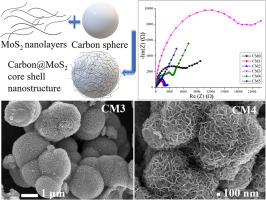Synergistic effects of Carbon@MoS2 core-shell nanostructures on charge dynamics for future optoelectronic applications
IF 4.7
3区 材料科学
Q2 MATERIALS SCIENCE, MULTIDISCIPLINARY
引用次数: 0
Abstract
The pursuit of advanced materials for enhancing optoelectronic device performance has led to significant interest in core-shell structures, which combine the unique properties of different materials to achieve superior functionality. This study investigates the hydrothermal synthesis of a series of core-shell Carbon@MoS2 materials with varying carbon concentrations, aiming to identify the optimal carbon content for enhanced optoelectronic applications. XRD analysis revealed the formation of new crystallographic phases, with crystallite sizes ranging from 1.39 nm to 23.1 nm, indicating significant structural modifications. UV–Vis analysis highlighted an expanded light absorption range and a reduction in bandgap up to 0.92 eV, particularly in carbon-loaded samples. Morphological analysis by FESEM and HRTEM confirmed the successful formation of core-shell nanospheres with well-defined MoS2 layers enveloping carbon cores. Electrochemical studies, including CV and PEIS, demonstrated that the sample CM4, with an optimal carbon concentration, exhibited balanced redox behavior, lower charge transfer resistance of 2860 Ω, and pronounced Warburg diffusion, marking it as the most effective composition for improving optoelectronic performance in future.

碳@MoS2 核壳纳米结构对未来光电应用中电荷动力学的协同效应
为了提高光电器件的性能,人们对先进材料的追求使得核壳结构备受关注,这种结构结合了不同材料的独特性能,从而实现了卓越的功能。本研究调查了一系列不同碳浓度的核壳 Carbon@MoS2 材料的水热合成,旨在确定增强光电应用的最佳碳含量。XRD 分析显示形成了新的结晶相,结晶尺寸从 1.39 纳米到 23.1 纳米不等,表明结构发生了显著变化。紫外可见光分析显示,光吸收范围扩大,带隙减小到 0.92 eV,特别是在碳负载样品中。利用 FESEM 和 HRTEM 进行的形貌分析证实,成功地形成了核壳纳米球,并在碳核外包覆了定义明确的 MoS2 层。包括 CV 和 PEIS 在内的电化学研究表明,具有最佳碳浓度的 CM4 样品表现出平衡的氧化还原行为、较低的电荷转移电阻(2860 Ω)和明显的沃伯格扩散,使其成为未来提高光电性能的最有效成分。
本文章由计算机程序翻译,如有差异,请以英文原文为准。
求助全文
约1分钟内获得全文
求助全文
来源期刊

Materials Chemistry and Physics
工程技术-材料科学:综合
CiteScore
8.70
自引率
4.30%
发文量
1515
审稿时长
69 days
期刊介绍:
Materials Chemistry and Physics is devoted to short communications, full-length research papers and feature articles on interrelationships among structure, properties, processing and performance of materials. The Editors welcome manuscripts on thin films, surface and interface science, materials degradation and reliability, metallurgy, semiconductors and optoelectronic materials, fine ceramics, magnetics, superconductors, specialty polymers, nano-materials and composite materials.
 求助内容:
求助内容: 应助结果提醒方式:
应助结果提醒方式:


